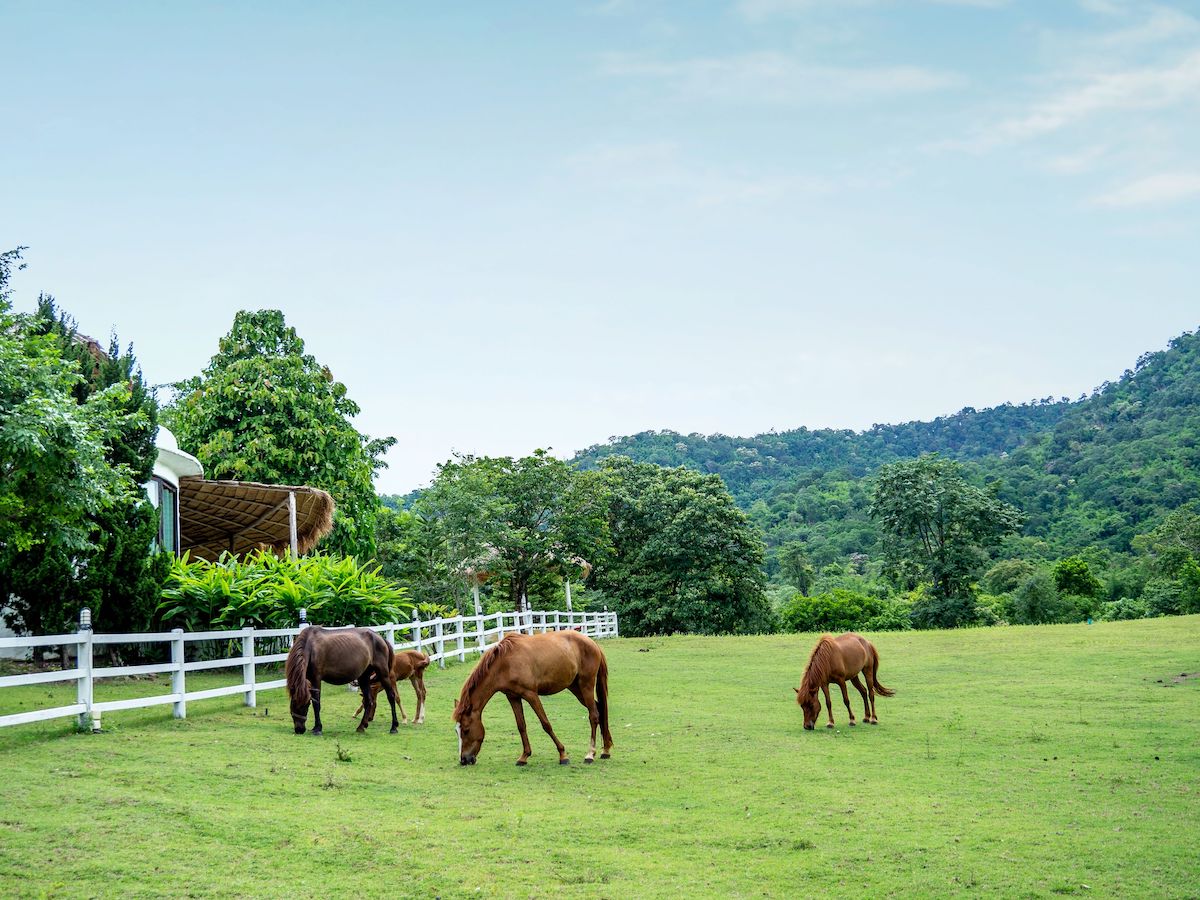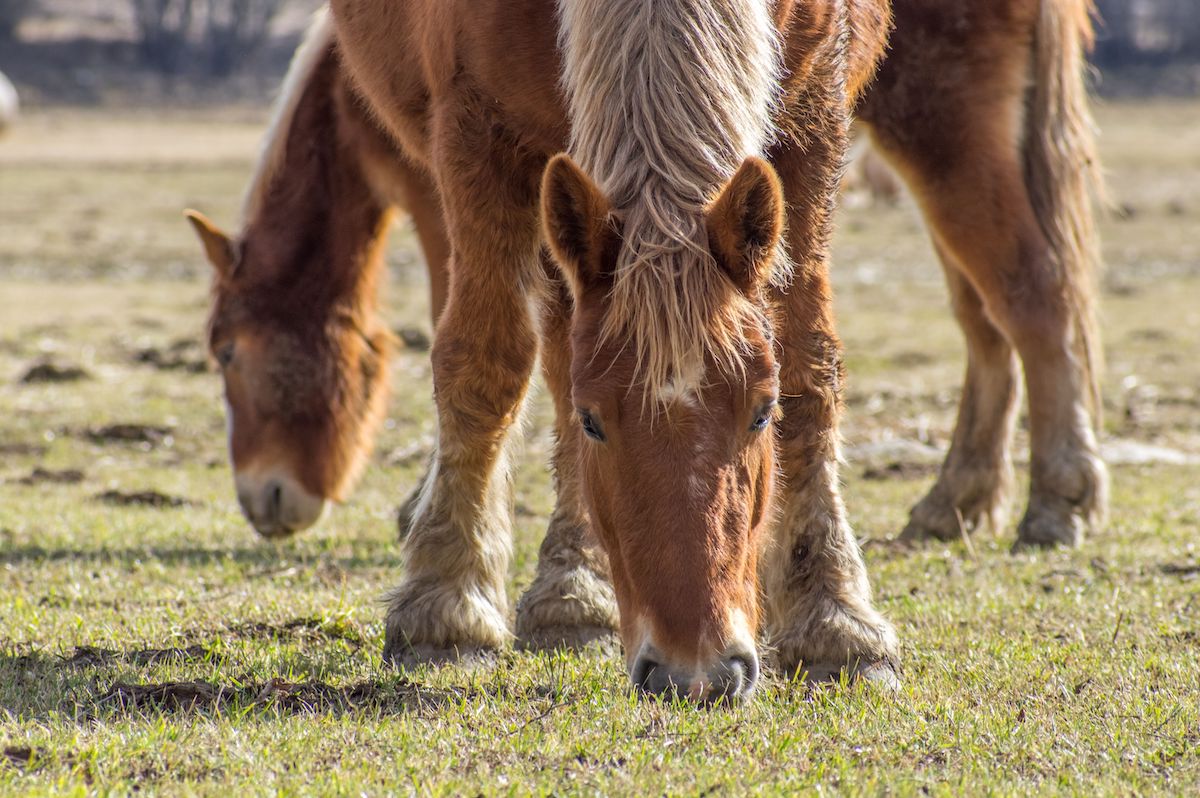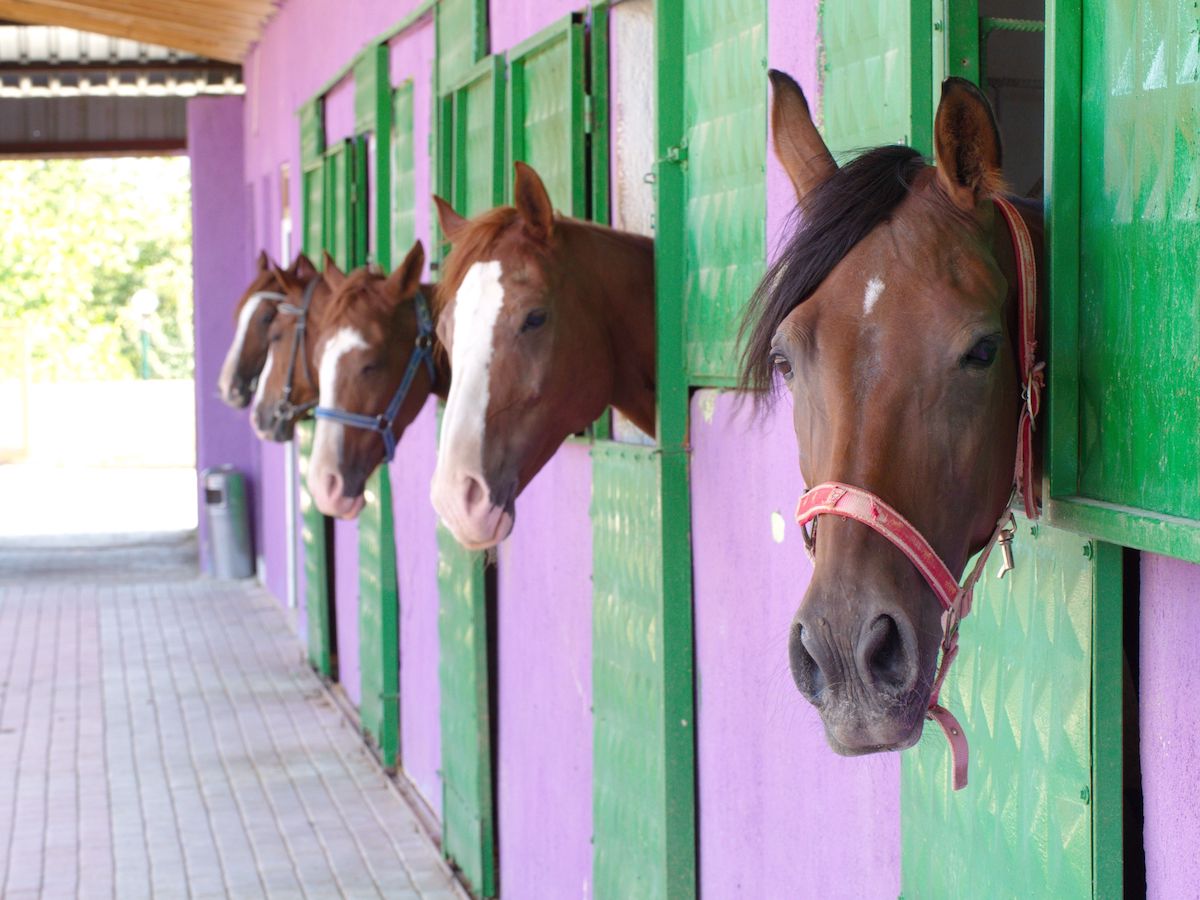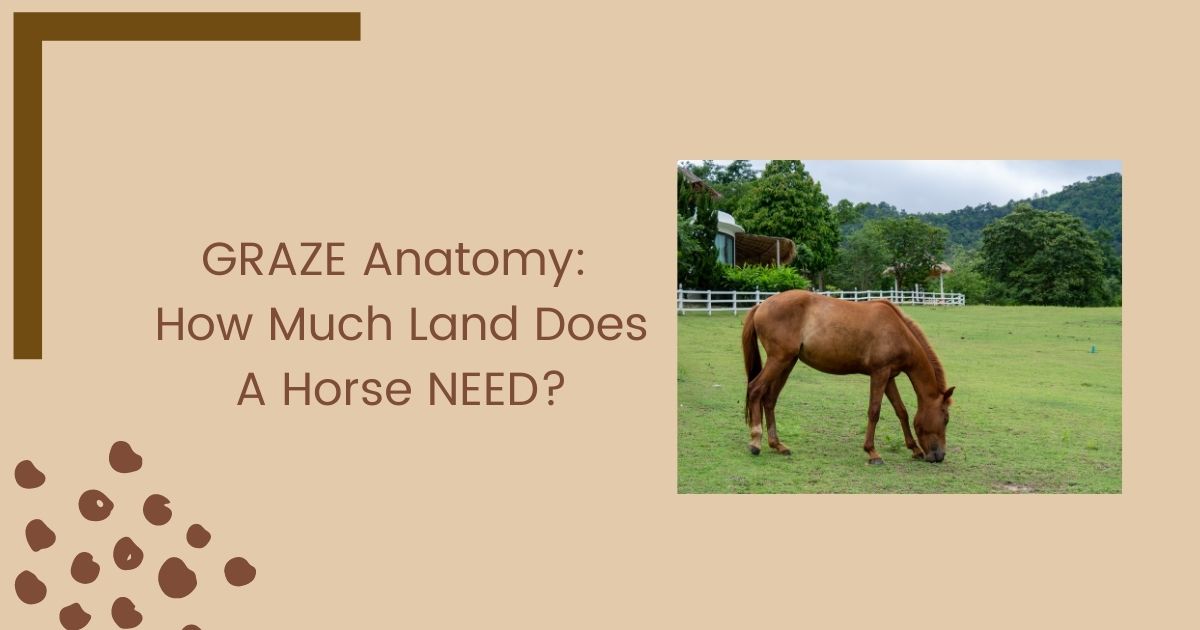How much land does a horse need to graze?
The answer to this question varies depending on what type of land is available, how many horses need to be grazed, how much supplementation is being provided in the pasture, and if rotational or continuous grazing methods will be used.
Horses do better on smaller pastures (rotated or not) than larger pastures (continuously grazed). Horses also do better on small-medium-sized fields with lower stocking rates rather than large pastures or ranges with high stocking rates.
Whether you have one or many horses, knowing their space requirements can help ensure they are healthy and happy in their environment. So let’s get started!
How Do You Go About Pasturing a Horse?
Horses are animals that thrive when given the freedom to roam. They love spending time outside, interacting with each other and their environment in ways few humans can understand.
However, suppose a pasture will serve as more than just an area for horse exercise (which most do). In that case, many factors need consideration, such as its nutritional value or carrying capacity.
Here are proven methods to keep your horse farm layout active and healthy for the benefit of your equine pals.
Improve Pasture Soil and Fertility
Caring for the land is not just about using it. It’s also about giving appreciated attention to the soil on which your horses live and work. For example, if pastures were previously cleared of vegetation, you could start planting grasses like bermudagrass, lovegrass, fescue, or rye.
Depending on what you want to accomplish with different types of grazing, you will need to use some kind of fertilization technique that incorporates some combination of nitrogen (N), phosphorus (P), and potassium (K).
These macronutrients are essential in sustaining plant growth and grass cover. In addition, they help determine how fast a pasture grows and how long it stays green during dry seasons or droughts. Nitrogen-rich fertilizers are particularly important in warm-season grasses since they help maintain overall plant health.
Avoid Overgrazing and Overstocking
There is such a thing as too much of a good thing when it comes to pasture management and feeding horses. Overgrazing will cause land degradation and erosion, while stocking rates that are too high will promote the spread of invasive plants and threaten animal health and safety.
The best way to avoid overgrazing or overstocking is by using an appropriate system for your pastures. For example, if you want to use rotational grazing, you should know each horse needs 0.75-one acre depending on age, weight, breed, and other factors such as gender (females need more space than males).
One acre per adult horse can sustain various grasses and adequate forage for continuous grazing purposes, but horses should have daily access to fresh pasture. It’s always a good idea to have at least 30% of the land in reserve from grazing to prevent overgrazing or degradation that may compromise your pastures’ carrying capacity.
Conduct Grazing Trials
To determine how many horses per acre of pasture, conduct a grazing trial by fencing off small areas of fields and using wire mesh collars around horses’ necks to monitor how much they eat or trample.
This will help you estimate how many acres are needed to support the appropriate number of horses on your farm, especially during droughts when grasses are scarce.
If you have limited land available for grazing purposes, then supplement with hay if necessary so that your pasture can recover before allowing more horses onto it.

Use Low Stocking Rates
It’s a good idea to keep your horses on small-medium-sized pastures with low stocking rates rather than large pastures or ranges with high stocking rates. This will ensure they have adequate space for grazing and interacting with one another and roam around without overcrowding.
Maintaining a healthy pasture doesn’t just benefit the land and your horses – it ensures that horses will lead better lives, especially in times of stress such as cold winters or when they can’t graze due to drought.
Can You Have a Horse on One Acre?
Keeping one horse on an acre of land may be possible if it is carefully managed, but how much land a horse needs depends on several factors such as breed, age, weight, type of pasture, and how often it is fed hay or other supplements.
In general, one acre per adult horse is a reasonable estimate for rotational grazing purposes, where horses are allowed onto fresh pasture daily before being moved elsewhere so that grasses have time to grow back. Horses should also have access to clean water at all times and have shelter from harsh weather conditions.
Horses should be able to graze for at least 12 hours each day throughout the winter without depleting the amount of green grass on your pastures.
Horses can also be kept on one acre of land if they are fed hay or other supplements, but how many acres per horse is truly dependent on how much space they need for grazing and how often you provide them these types of foods.
For example, giving your horses two to three bales of hay daily throughout the winter will decrease how many acres per horse are needed to sustain their nutrient requirements for growth and health.
However, using this method requires more land than necessary since some pastures could go unused during these months while others are overtaxed by how much your horses eat, how often they are fed hay, how many horses you have in total, and how often you rotate them between pastures.
So the bottom line is that if you have one acre of land for each adult horse, this will be sufficient to sustain growth and health during the summer months when grasses are plentiful.
However, it won’t be sufficient if they are fed large amounts of food, especially during the winter when green pastures are unavailable for them to graze on. This can lead to malnutrition regardless of how many acres per horse you have since pasture doesn’t provide adequate nutrients for growing animals.

The Four Factors That Influence The Amount of Land Required
Four factors influence the amount of land required per horse:
- Physiology – A breed with a vast, high-maintenance coat may need more land to keep warm in the wintertime. A younger horse would require less land in the long run because it wouldn’t need to eat as much. A horse’s age can also greatly affect how many acres they would need, with senior horses requiring less land.
- Climate & Environment – Horses require shelter from the elements, particularly in extreme climates. Horses also need sources of water. If there are no sources of grass on the land, nor any water, you would have to buy resources for the horse to eat.
- Feed & Forage Availability – Horses need a wide variety of grasses and hay to sustain themselves. If there isn’t enough grass to feed a horse, it would need supplements in the form of grain.
- Management Practices – The more land the horse has access to, the less often it will require rotation. However, if there isn’t enough water or edible resources, you would need to rotate the pasture frequently and offer water and supplements. Horses stocked at a high level can quickly deplete the land of their resources, so you need to rotate more regularly and offer water and supplements.
How Much Land Does a Horse Need?
Smaller horse breeds only need half an acre of land, while larger ones can eat up to two acres.
This means that horse owners will need more land if their horse is under the age of ten because it requires less food than an older horse to support growth and health, especially since pastures only contain green grasses during the summer months in some horses regions.
As horse owners, you should always ensure your horse has access to shelter and drinking water even if they’re provided with pasture grazing on a regular or rotational basis, especially when horse pastures only contain green grasses during the summer months.
This means that minimum acreage for a horse can range between one-half acre of land all year round for every horse when horses graze throughout longer periods each day without it growing back within 24 hours. It goes up to two acres of land per horse during the spring and summer months when there’s more available grass for them to eat.
However, horse owners also need to consider how much horse feed is required per day to sustain growth and health if horse pastures only contain grasses during the summer months. So horse acreage requirements vary based on horse age, breed, weight, or nutritional needs.

Which 5 Factors Impact The Quality of Grazing Land?
As horse owners, it’s vital to consider horse acreage requirements versus the quality of horse pastures regularly so they have access to enough land for grazing purposes.
For example, many factors can affect grasses’ availability and nutritional content in horse pastures after being grazed for extended periods each day, including weather conditions, poor management practices, or inadequate fencing.
But five main factors impact the quality of horse pasture all year round regardless of seasonal conditions or climate change which includes:
- Soil quality
- Weather conditions
- Horse breeds and weights
- Horse grazing preferences
- Horse fencing
Larger Horse Pastures vs. Smaller Horse Pastures
Horse owners must also determine whether to keep their horse on larger or smaller acreage depending on how many horses are being kept, what type of climate they live in, and if their horse has access to free-range opportunities.
For example, keeping a single riding mare with one foal per year on three acres of pasture may be sufficient to maintain optimal horse health, particularly in warmer climates where grasses are more nutritiously rich during the winter months.
But keeping four trotting ponies on less than three acres of pasture will likely lead to malnutrition if green grasses are only available for grazing during the summer months when grasses become too sparse for nutritional needs.
Similarly, keeping a single draft horse in a colder climate on less than one acre of pasture would likely lead to malnutrition. Their larger frame and higher nutritional requirements would need at least three acres of pasture to maintain good horse health.
But keeping four lighter riding horses in the same colder climate on around one-quarter acre per horse provides sufficient land area to minimize competition for food sources while keeping all of the horses in good health.
To avoid malnutrition, owners should check with their local county Extension Agent to get more information on how many acres per horse are potentially needed before deciding how many horses they want to keep in their care.
Our Top Tips For Managing Horse Land
Horse keeping has been a popular practice for centuries, and keeping horses on small acreage is still a thriving business today.
However, housekeeping on a small acreage does require that owners take more precautions to ensure their horses are getting enough land resources to maintain good nutrition and adequate living conditions.
Here are our top tips for keeping your horse’s land resources healthy:
Horse Fencing
Don’t skimp on good quality materials or good installation practices. If you don’t have the tools or expertise to install your horse fence properly, hire someone who can do it well so you know your fencing will last for many years without needing replacement.
Landscape Design
Prioritize how much of your landscape area should be dedicated to keeping your horse’s living quarters, keeping your horse’s feeding area next to his living quarters, and how much of the remaining land area should be dedicated to maintaining an outdoor working arena.
Water Availability
Off-the-ground tanks or troughs are the best choices since they don’t take up pasture space, but make sure you can access them without having to leave the safety of your horse fencing. Horses must always have access to adequate water sources, even on field pastures.
Horse Shelter
Ensure that your horse has at least three types of shelter depending on where they spend most of their time (e.g., if they spend most of their time outside in a larger paddock area, they should have a three-sided horse shelter for keeping dry in inclement weather).
Horse farm layout
At least one acre per horse is the recommended minimum acreage for a horse, but you will need more land resources if your horses spend their time in any of the following situations:
- If two horses are kept together, but only one has free access to an outdoor working arena or larger pasture area.
- If keeping several horses in a field requires moving pastures at least every three months during the growing season so that all of your horses can gain access to ample food sources and avoid having too many dominance fights over food access.
- If keeping more than four horses that do not have free access to an outdoor working arena.
Keeping four horses on small acreage is certainly possible, but you will need to follow these management tips to ensure your horse’s well-being without keeping them in a malnourished condition.
The Advantages of Proper Pasture Management
There are many reasons why it’s essential to manage your pastures properly. When you have well-managed pasture, your horse will live a healthier life for many years.
- Good pasture management ensures that horses have enough land to graze on without causing damage to their pastures.
- Healthy grasses will keep the horses eating throughout the day, so they aren’t just eating at night when it is more stressful.
- Better weight gain in pregnant mares and developing young horses can be achieved with adequate nutrition from good pasture management practices.
- Keeping your pastures healthy helps improve soil fertility, leading to better grazing yields over time with less fertilization needed to maintain good plant health.
- The enhanced aesthetic value of your landscape can help you sell or market your horse property.
So, when it comes to keeping horses on small acreages, good pasture management practices are essential for ensuring their well-being throughout the years. Ensuring they have enough land resources will make them live happy and healthy lives while also protecting your investment in them!
Managing The Challenges Associated With Small Pastures
Small pastures can be challenging to manage properly if you don’t have the necessary knowledge. This may cause long-term health problems with your horses.
There are, however, ways to keep your horse on a smaller acreage and avoid some common problems associated with keeping too many horses per pasture land resource.
- When possible, it is best to give each horse their own turn at free access to an outdoor working arena or larger paddock area (large enough for territorial displays between herd members). Horses only need to be in this area during daylight hours because most of their sleeping will happen at night when they are contained within their shelter areas.
- Your horses should be kept in a neighborhood setting with at least a 10-foot buffer between other horses on adjacent pastures. This will ensure you have enough land resources to grow healthy grasses and avoid having too many dominance battles among your horses.
- Creating a rotational grazing plan that moves the pastures every three months during the growing season is an excellent way to keep your horse on a smaller pasture acreage while still giving them access to adequate food sources throughout the growing season.
- However, keeping more than four horses on one acre of land should be done only if all of these management strategies are being utilized together. In most cases, you will need more than one to two acres per horse, depending on how well they can get along with their herd mates and what types of pastures are available.
- Always make sure there are at least 20 square feet of pasture space per horse on your property (single or multi-horse, this rule always stays the same). This will help reduce territorial dominance fights among horses and keep them from injuring themselves by eating enough food resources.
- Never keep other horses with stallions because they will fight for territory more often than geldings or mares.
- Sufficient shelter should be provided that includes an open run-in shed that allows access to sunlight throughout most of the year during daylight hours so horses can graze without fear of over-exertion on sunny summer days. The shelter area should also protect horses from cold winter winds and winter snowdrifts.
- Local zoning by-laws will often allow horses to be kept on smaller acreages as long as the land is appropriately managed with good rotational grazing practices and an adequate turnout routine that provides access to fresh pasture daily. This is a charge that should always be met when keeping horses on your property.
- Always make sure you follow all of your State Veterinary Board guidelines about proper fencing requirements for keeping horses on small acreages. Better safe than sorry is the best way to approach this subject because keeping too many horses in a tiny area can quickly become overcrowded if not monitored correctly.
- Always remember to have a proper veterinarian on hand for any emergencies with your horses, and make sure they are current on all shots, so you don’t have an outbreak of contagious or fatal diseases.
By following these simple management guidelines, you will be able to keep your horses safe from the dangers of being overcrowded in small acreages while still enjoying fresh pasture throughout most of the year.
The Final NEIGH
Horses require a lot of space, but you can keep your horse on less than an acre with the correct management practices. Follow these guidelines and check your local zoning requirements before deciding to keep your horse on an acreage.
